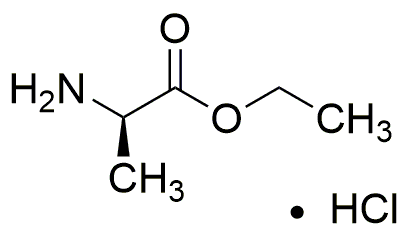D-Alanine ethyl ester hydrochloride is widely utilized in research focused on:
- Pharmaceutical Development: This compound serves as an important building block in the synthesis of various pharmaceuticals, particularly in the development of peptide-based drugs.
- Biochemical Research: It is commonly used in studies related to amino acid metabolism and protein synthesis, aiding researchers in understanding cellular processes.
- Neuroscience: D-Alanine ethyl ester hydrochloride is investigated for its potential role as a neurotransmitter modulator, which could lead to advancements in treating neurological disorders.
- Food Industry: This chemical is explored for its use as a flavor enhancer or additive, providing a unique taste profile in food products.
- Cosmetic Formulations: Its properties make it a candidate for inclusion in skincare products, where it may contribute to hydration and skin health.
General Information
Properties
Safety and Regulations
Applications
D-Alanine ethyl ester hydrochloride is widely utilized in research focused on:
- Pharmaceutical Development: This compound serves as an important building block in the synthesis of various pharmaceuticals, particularly in the development of peptide-based drugs.
- Biochemical Research: It is commonly used in studies related to amino acid metabolism and protein synthesis, aiding researchers in understanding cellular processes.
- Neuroscience: D-Alanine ethyl ester hydrochloride is investigated for its potential role as a neurotransmitter modulator, which could lead to advancements in treating neurological disorders.
- Food Industry: This chemical is explored for its use as a flavor enhancer or additive, providing a unique taste profile in food products.
- Cosmetic Formulations: Its properties make it a candidate for inclusion in skincare products, where it may contribute to hydration and skin health.
Documents
Safety Data Sheets (SDS)
The SDS provides comprehensive safety information on handling, storage, and disposal of the product.
Product Specification (PS)
The PS provides a comprehensive breakdown of the product’s properties, including chemical composition, physical state, purity, and storage requirements. It also details acceptable quality ranges and the product's intended applications.
Certificates of Analysis (COA)
Search for Certificates of Analysis (COA) by entering the products Lot Number. Lot and Batch Numbers can be found on a product’s label following the words ‘Lot’ or ‘Batch’.
*Catalog Number
*Lot Number
Certificates Of Origin (COO)
This COO confirms the country where the product was manufactured, and also details the materials and components used in it and whether it is derived from natural, synthetic, or other specific sources. This certificate may be required for customs, trade, and regulatory compliance.
*Catalog Number
*Lot Number
Safety Data Sheets (SDS)
The SDS provides comprehensive safety information on handling, storage, and disposal of the product.
DownloadProduct Specification (PS)
The PS provides a comprehensive breakdown of the product’s properties, including chemical composition, physical state, purity, and storage requirements. It also details acceptable quality ranges and the product's intended applications.
DownloadCertificates of Analysis (COA)
Search for Certificates of Analysis (COA) by entering the products Lot Number. Lot and Batch Numbers can be found on a product’s label following the words ‘Lot’ or ‘Batch’.
*Catalog Number
*Lot Number
Certificates Of Origin (COO)
This COO confirms the country where the product was manufactured, and also details the materials and components used in it and whether it is derived from natural, synthetic, or other specific sources. This certificate may be required for customs, trade, and regulatory compliance.


